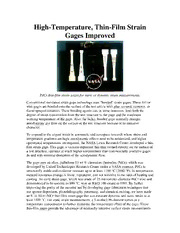
NASA Technical Reports Server (NTRS) 20050170415: High-Temperature, Thin-Film Strain Gages Improved PDF
Preview NASA Technical Reports Server (NTRS) 20050170415: High-Temperature, Thin-Film Strain Gages Improved
High-Temperature, Thin-Film Strain Gages Improved PdCr thin-film strain gages for static or dynamic strain measurements. Conventional resistance strain gage technology uses "bonded" strain gages. These foil or wire gages are bonded onto the surface of the test article with glue, ceramic cements, or flame-sprayed ceramics. These bonding agents can, in some instances, limit both the degree of strain transmission from the test structure to the gage and the maximum working temperature of the gage. Also, the bulky, bonded gage normally disrupts aerodynamic gas flow on the surface of the test structure because of its intrusive character. To respond to the urgent needs in aeronautic and aerospace research where stress and temperature gradients are high, aerodynamic effects need to be minimized, and higher operational temperatures are required, the NASA Lewis Research Center developed a thin- film strain gage. This gage, a vacuum-deposited thin film formed directly on the surface of a test structure, operates at much higher temperatures than commercially available gages do and with minimal disruption of the aerodynamic flow. The gage uses an alloy, palladium-13 wt % chromium (hereafter, PdCr), which was developed by United Technologies Research Center under a NASA contract. PdCr is structurally stable and oxidation resistant up to at least 1100 °C (2000 °F); its temperature- induced resistance change is linear, repeatable, and not sensitive to the rates of heating and cooling. An early strain gage, which was made of 25-micrometer-diameter PdCr wire and demonstrated to be useable to 800 °C, won an R&D 100 award in 1991. By further improving the purity of the material and by developing gage fabrication techniques that use sputter-deposition, photolithography patterning, and chemical etching, we have made an 8- to 10-m PdCr thin-film strain gage that can measure dynamic and static strain to at least 1100 °C. For static strain measurements, a 5-m-thick Pt element serves as a temperature compensator to further minimize the temperature effect of the gage. These thin-film gages provide the advantage of minimally intrusive surface strain measurements and give highly repeatable readings with low drift at temperatures from ambient to 1100 °C. This is a 300 °C advance in operating temperature over the PdCr wire gage and a 500 °C advance over commercially available gages made of other materials. Mechanical response of a PdCr thin-film strain gage. Bibliography Lei, J.-F.: High Temperature Thin Film Strain Gages. HITEMP Review 1994, NASA CP- 10146, Vol. I, 1994, pp. 25-1 to 25-13. (Available to U.S. citizens only. Permission to use this material was granted by Hugh R. Gray, January 1996.)
